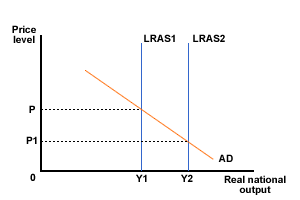Syllabus: The role of supply-side policies
Syllabus: Explain that supply-side policies aim at positively affecting the production side of an economy by improving the institutional framework and the capacity to produce (that is, by changing the quantity and/or quality of factors of production).Supply-side policies are designed to make the production
potential (also called Capacity, Full Employment) greater. In other
words to shift LRAS to the right.
Supply-side policies tend to concentrate on improving efficiencies in either product markets, i.e. specific goods and/or services such as cars, tourism or labour markets. Supply-side policies are designed to increase competition and efficiency of production by improving the quality and quantity of Factors of Production including labour available to firms. When combined with other macro policies, they deliver a more competitive and efficient economy.
Supply-side policies focus on:
- Removing market imperfections - barriers to the smooth operation of product and labour markets
- Removing restrictive practices - rules that do not allow the free movement of factors within an economy
- Making work more rewarding - increase incentives to work
- Making workers more efficient
Supply-side policies aim to shift the LRAS curve to the right, increasing the level of real output and putting downward pressure on the price level. This is shown in Figure 1 below:

Figure 1 Supply-side policies - LRAS shifts
Syllabus: State
that supply-side policies may be market-based or interventionist, and
that in either case they aim to shift the LRAS curve to the right,
achieving growth in potential output.
Supply-side policies were initially advocated only by free-market oriented economists and politicians. However, policies designed to affect the aggregate supply of goods and services are now embraced by those in favour of a more interventionist approach. It may, therefore, be better to think of supply-side policies in terms of being either market based or interventionist.
In Brazil president Lula initiated the Accelerated Growth Programme (Programa de Aceleração do Crescimento - PAC)
The Growth Acceleration Program involves investments by the Federal government, state enterprises and the private sector in construction, sanitation, energy, transport and logistics